-

两条平行线间的距离教学设计人教A版高中数学选择性必修第一册
一、情境导学前面我们已经得到了两点间的距离公式,点到直线的距离公式,关于平面上的距离问题,两条直线间的距离也是值得研究的。思考1:立定跳远测量的什么距离?A.两平行线的距离 B.点到直线的距离 C. 点到点的距离二、探究新知思考2:已知两条平行直线l_1,l_2的方程,如何求l_1 〖与l〗_2间的距离?根据两条平行直线间距离的含义,在直线l_1上取任一点P(x_0,y_0 ),,点P(x_0,y_0 )到直线l_2的距离就是直线l_1与直线l_2间的距离,这样求两条平行线间的距离就转化为求点到直线的距离。两条平行直线间的距离1. 定义:夹在两平行线间的__________的长.公垂线段2. 图示: 3. 求法:转化为点到直线的距离.1.原点到直线x+2y-5=0的距离是( )A.2 B.3 C.2 D.5D [d=|-5|12+22=5.选D.]
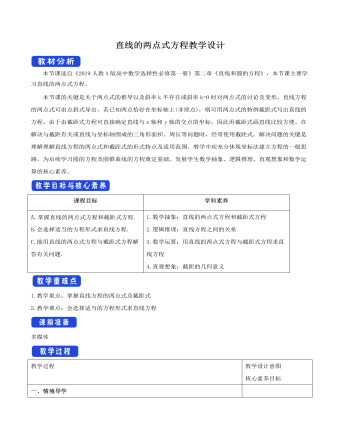
直线的两点式方程教学设计人教A版高中数学选择性必修第一册
解析:①过原点时,直线方程为y=-34x.②直线不过原点时,可设其方程为xa+ya=1,∴4a+-3a=1,∴a=1.∴直线方程为x+y-1=0.所以这样的直线有2条,选B.答案:B4.若点P(3,m)在过点A(2,-1),B(-3,4)的直线上,则m= . 解析:由两点式方程得,过A,B两点的直线方程为(y"-(-" 1")" )/(4"-(-" 1")" )=(x"-" 2)/("-" 3"-" 2),即x+y-1=0.又点P(3,m)在直线AB上,所以3+m-1=0,得m=-2.答案:-2 5.直线ax+by=1(ab≠0)与两坐标轴围成的三角形的面积是 . 解析:直线在两坐标轴上的截距分别为1/a 与 1/b,所以直线与坐标轴围成的三角形面积为1/(2"|" ab"|" ).答案:1/(2"|" ab"|" )6.已知三角形的三个顶点A(0,4),B(-2,6),C(-8,0).(1)求三角形三边所在直线的方程;(2)求AC边上的垂直平分线的方程.解析(1)直线AB的方程为y-46-4=x-0-2-0,整理得x+y-4=0;直线BC的方程为y-06-0=x+8-2+8,整理得x-y+8=0;由截距式可知,直线AC的方程为x-8+y4=1,整理得x-2y+8=0.(2)线段AC的中点为D(-4,2),直线AC的斜率为12,则AC边上的垂直平分线的斜率为-2,所以AC边的垂直平分线的方程为y-2=-2(x+4),整理得2x+y+6=0.

两点间的距离公式教学设计人教A版高中数学选择性必修第一册
一、情境导学在一条笔直的公路同侧有两个大型小区,现在计划在公路上某处建一个公交站点C,以方便居住在两个小区住户的出行.如何选址能使站点到两个小区的距离之和最小?二、探究新知问题1.在数轴上已知两点A、B,如何求A、B两点间的距离?提示:|AB|=|xA-xB|.问题2:在平面直角坐标系中能否利用数轴上两点间的距离求出任意两点间距离?探究.当x1≠x2,y1≠y2时,|P1P2|=?请简单说明理由.提示:可以,构造直角三角形利用勾股定理求解.答案:如图,在Rt △P1QP2中,|P1P2|2=|P1Q|2+|QP2|2,所以|P1P2|=?x2-x1?2+?y2-y1?2.即两点P1(x1,y1),P2(x2,y2)间的距离|P1P2|=?x2-x1?2+?y2-y1?2.你还能用其它方法证明这个公式吗?2.两点间距离公式的理解(1)此公式与两点的先后顺序无关,也就是说公式也可写成|P1P2|=?x2-x1?2+?y2-y1?2.(2)当直线P1P2平行于x轴时,|P1P2|=|x2-x1|.当直线P1P2平行于y轴时,|P1P2|=|y2-y1|.
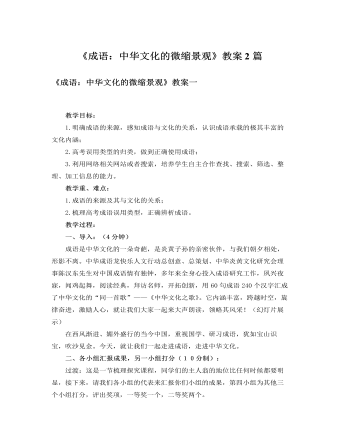
人教版高中语文必修2《成语:中华文化的微缩景观》教案2篇
七、教学反思这堂课有眼下看得见的效果和暂时看不见的长远的效果,学生收益明显:1.学生学到的不只是成语本身。学生从网络上搜集材料,分析整理,不只是学成语,探究能力也得到提高。对成语的梳理探究,是让学生做一件很具体的事——梳理、分析、归类。重在过程,重在课外、课前学生的工作。这样的教学设计很有价值,让学生在活动中得到提高。2.开拓了学生的眼界。学生放眼各种报刊,从报刊中发现问题——大家都可能出错。这样一来学生的眼界变宽了,自信心增强了。3.对成语的理解、运用比过去深刻。让学生从对一个个具体成语的理解入手,进而认识到以后用成语不能犯“望文生义”等错误,从个例上升到一般。4.让学生知道以后自己运用成语应抱什么态度,用什么方法。别人错用成语,是前车之鉴。
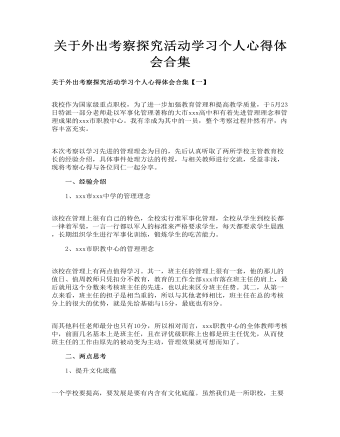
关于外出考察探究活动学习个人心得体会合集
1、xxx市xxx中学的管理理念 该校在管理上很有自己的特色,全校实行准军事化管理,全校从学生到校长都一律着军装,一言一行都以军人的标准来严格要求学生,每天都要求学生晨跑,长期组织学生进行军事化训练,锻炼学生的吃苦能力。 2、xxx市职教中心的管理理念 该校在管理上有两点值得学习。其一,班主任的管理上很有一套,他的那儿的值日、值周教师只凭扣分不教育,教育的工作全部xxx市落在班主任的肩上,最后就用这个分数来考核班主任的先进,也以此来区分班主任费。其二,从第一点来看,班主任的担子是相当重的,所以与其他老师相比,班主任在总的考核分上的很大的优势,就是先给基础与15分,最底也有8分。
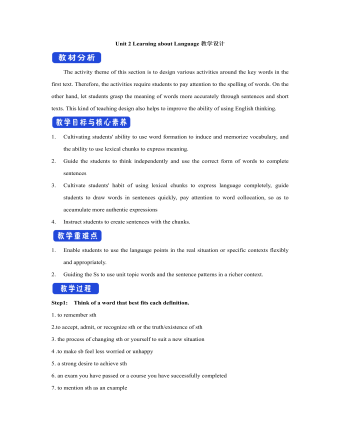
新人教版高中英语选修2Unit 2 Learning about Language教学设计
The activity theme of this section is to design various activities around the key words in the first text. Therefore, the activities require students to pay attention to the spelling of words. On the other hand, let students grasp the meaning of words more accurately through sentences and short texts. This kind of teaching design also helps to improve the ability of using English thinking.1. Cultivating students' ability to use word formation to induce and memorize vocabulary, and the ability to use lexical chunks to express meaning.2. Guide the students to think independently and use the correct form of words to complete sentences3. Cultivate students' habit of using lexical chunks to express language completely, guide students to draw words in sentences quickly, pay attention to word collocation, so as to accumulate more authentic expressions4. Instruct students to create sentences with the chunks.1. Enable students to use the language points in the real situation or specific contexts flexibly and appropriately.2. Guiding the Ss to use unit topic words and the sentence patterns in a richer context.Step1: Think of a word that best fits each definition.1. to remember sth2.to accept, admit, or recognize sth or the truth/existence of sth3. the process of changing sth or yourself to suit a new situation4 .to make sb feel less worried or unhappy5. a strong desire to achieve sth
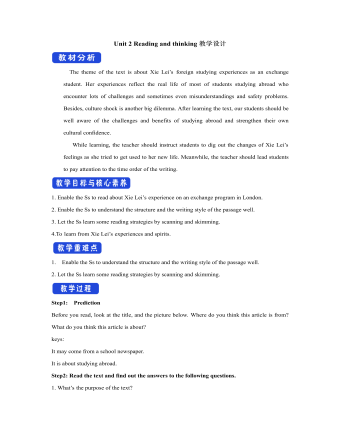
新人教版高中英语选修2Unit 2 Reading and thinking教学设计
Her tutor told her to acknowledge __________ other people had said if she cited their ideas, and advised her _______(read) lots of information in order to form __________wise opinion of her own.Now halfway __________ her exchange year, Xie Lei felt much more at home in the UK. She said __________ (engage) in British culture had helped and that she had been__________ (involve) in social activities. She also said while learning about business, she was acting as a cultural messenger __________(build) a bridge between the two countries. keys:Xie Lei, a 19yearold Chinese student, said goodbye to her family and friends in China and boarded (board) a plane for London six months ago in order to get a business qualification. She was ambitious(ambition) to set up a business after graduation. It was the first time that she had left (leave) home.At first, Xie Lei had to adapt to life in a different country. She chose to live with a host family, who can help with her adaptation (adapt) to the new culture. When she missed home, she felt comforted (comfort) to have a second family. Also Xie Lei had to satisfy academic requirements. Her tutor told her to acknowledge what other people had said if she cited their ideas, and advised her to read lots of information in order to form a wise opinion of her own.Now halfway through her exchange year, Xie Lei felt much more at home in the UK. She said engaging (engage) in British culture had helped and that she had been involved (involve) in social activities. She also said while learning about business, she was acting as a cultural messenger building a bridge between the two countries.
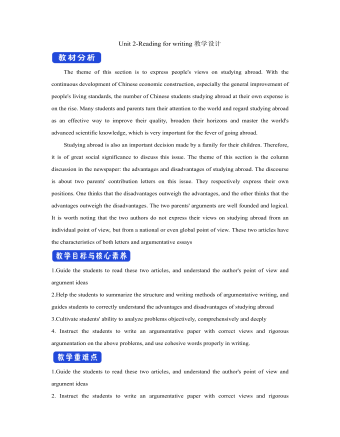
新人教版高中英语选修2Unit 2 Reading for writing教学设计
The theme of this section is to express people's views on studying abroad. With the continuous development of Chinese economic construction, especially the general improvement of people's living standards, the number of Chinese students studying abroad at their own expense is on the rise. Many students and parents turn their attention to the world and regard studying abroad as an effective way to improve their quality, broaden their horizons and master the world's advanced scientific knowledge, which is very important for the fever of going abroad. Studying abroad is also an important decision made by a family for their children. Therefore, it is of great social significance to discuss this issue. The theme of this section is the column discussion in the newspaper: the advantages and disadvantages of studying abroad. The discourse is about two parents' contribution letters on this issue. They respectively express their own positions. One thinks that the disadvantages outweigh the advantages, and the other thinks that the advantages outweigh the disadvantages. The two parents' arguments are well founded and logical. It is worth noting that the two authors do not express their views on studying abroad from an individual point of view, but from a national or even global point of view. These two articles have the characteristics of both letters and argumentative essays1.Guide the students to read these two articles, and understand the author's point of view and argument ideas2.Help the students to summarize the structure and writing methods of argumentative writing, and guides students to correctly understand the advantages and disadvantages of studying abroad3.Cultivate students' ability to analyze problems objectively, comprehensively and deeply
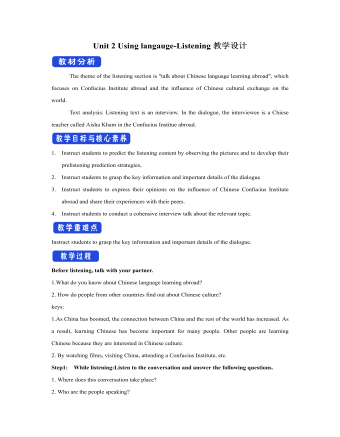
新人教版高中英语选修2Unit 2 Using langauge-Listening教学设计
? B: Absolutely! Getting involved with Chinese cultural activities there definitely helped a lot. I got to practice my Chinese on a daily basis, and I could learn how native Chinese speakers spoke.? A: What do you feel is your biggest achievement?? B: Learning Chinese characters! I have learnt about 1,500 so far. When I first started, I didn't think it was even going to be possible to learn so many, but now I find that I can read signs, menus, and even some easy newspaper articles.? A: What are you most keen on?? B: I've really become keen on learning more about the Chinese culture, in particular Chinese calligraphy. As I have learnt Chinese characters, I have developed a great appreciation for their meaning. I want to explore Chinese characters by learning how to write them in a more beautiful way. ? A: Finally, what do you want to say to anyone interested in learning Chinese?? I have really become keen on learning more about the Chinese culture, in particular Chinese Calligraphy. As I have learnt Chinese character, I have developed a great appreciation for their meaning. I want to explore Chinese characters by learning how to write them in a more beautiful way.? A: Finally, what do you want to say to anyone interested in learning Chinese?? B: I'd say, give it a shot! While some aspects may be difficult, it is quite rewarding and you will be happy that you tried.? A: Thanks for your time. ? B:You're welcome.

人教A版高中数学必修一基本不等式教学设计(2)
《基本不等式》在人教A版高中数学第一册第二章第2节,本节课的内容是基本不等式的形式以及推导和证明过程。本章一直在研究不等式的相关问题,对于本节课的知识点有了很好的铺垫作用。同时本节课的内容也是之后基本不等式应用的必要基础。课程目标1.掌握基本不等式的形式以及推导过程,会用基本不等式解决简单问题。2.经历基本不等式的推导与证明过程,提升逻辑推理能力。3.在猜想论证的过程中,体会数学的严谨性。数学学科素养1.数学抽象:基本不等式的形式以及推导过程;2.逻辑推理:基本不等式的证明;3.数学运算:利用基本不等式求最值;4.数据分析:利用基本不等式解决实际问题;5.数学建模:利用函数的思想和基本不等式解决实际问题,提升学生的逻辑推理能力。重点:基本不等式的形成以及推导过程和利用基本不等式求最值;难点:基本不等式的推导以及证明过程.

倾斜角与斜率教学设计人教A版高中数学选择性必修第一册
(2)l的倾斜角为90°,即l平行于y轴,所以m+1=2m,得m=1.延伸探究1 本例条件不变,试求直线l的倾斜角为锐角时实数m的取值范围.解:由题意知(m"-" 1"-" 1)/(m+1"-" 2m)>0,解得1<m<2.延伸探究2 若将本例中的“N(2m,1)”改为“N(3m,2m)”,其他条件不变,结果如何?解:(1)由题意知(m"-" 1"-" 2m)/(m+1"-" 3m)=1,解得m=2.(2)由题意知m+1=3m,解得m=1/2.直线斜率的计算方法(1)判断两点的横坐标是否相等,若相等,则直线的斜率不存在.(2)若两点的横坐标不相等,则可以用斜率公式k=(y_2 "-" y_1)/(x_2 "-" x_1 )(其中x1≠x2)进行计算.金题典例 光线从点A(2,1)射到y轴上的点Q,经y轴反射后过点B(4,3),试求点Q的坐标及入射光线的斜率.解:(方法1)设Q(0,y),则由题意得kQA=-kQB.∵kQA=(1"-" y)/2,kQB=(3"-" y)/4,∴(1"-" y)/2=-(3"-" y)/4.解得y=5/3,即点Q的坐标为 0,5/3 ,∴k入=kQA=(1"-" y)/2=-1/3.(方法2)设Q(0,y),如图,点B(4,3)关于y轴的对称点为B'(-4,3), kAB'=(1"-" 3)/(2+4)=-1/3,由题意得,A、Q、B'三点共线.从而入射光线的斜率为kAQ=kAB'=-1/3.所以,有(1"-" y)/2=(1"-" 3)/(2+4),解得y=5/3,点Q的坐标为(0,5/3).

小学语文一年级下册第2课《春雨的色彩》优秀教案范文
精读课文,理解积累 1、同学们的字记的很好,课文也一定能读出感情来。现在就请同学们带着自己的理解和感受,有感情地读一遍课文,并自己喜欢的一段精读。 2、讨论交流,指导朗读 调整方案: 方案一:通过读文你知道了什么?(这一问题较开放,如果学生已从整体上感知课文内容,即可进入下一环节。如果学生回答只停留在零散的词句上,就按方案二教学。) 方案二:小燕子、麻雀和黄莺它们分别认为春雨是什么色的?他们为什么这么认为?(板贴写有字的小写图片和对应的颜色) 3、小组内讨论:a.如果分角色朗读的话,该怎样读争论的语法,朗读好“不对”“不对,不对”“你们瞧”b.怎样表现春雨小鸟和大自然。 4、根据自己的理解感受小组内分角色读、表演读。 5、请一组同学配乐表演读,学生评价 6、同学们春雨到底是什么颜色的呢?把你的想法说一说,画一画(自选粉笔板画春雨) 7、指导积累。同学们读得真有感情,现在请把你喜欢的词句画下来。
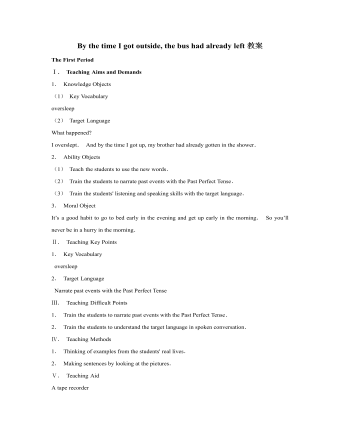
人教版新目标初中英语九年级下册By the time I got outside, the bus had already left教案
Ⅰ. Teaching Aims and Demands1. Knowledge Objects(1) Key Vocabularyoversleep(2) Target LanguageWhat happened?I overslept. And by the time I got up, my brother had already gotten in the shower.2. Ability Objects(1) Teach the students to use the new words.(2) Train the students to narrate past events with the Past Perfect Tense.(3) Train the students' listening and speaking skills with the target language.3. Moral ObjectIt’s a good habit to go to bed early in the evening and get up early in the morning. So you’ll never be in a hurry in the morning.Ⅱ. Teaching Key Points1. Key Vocabularyoversleep2. Target LanguageNarrate past events with the Past Perfect TenseⅢ. Teaching Difficult Points1. Train the students to narrate past events with the Past Perfect Tense.2. Train the students to understand the target language in spoken conversation.Ⅳ. Teaching Methods1. Thinking of examples from the students' real lives.2. Making sentences by looking at the pictures.Ⅴ. Teaching AidA tape recorderⅥ. Teaching ProceduresStep I Revision1. Revise the language points in Unit 8.Ask some questions like this: What volunteer work would you like to do?Help the students to answer, I’d like to…/I love to…/I hope to2. Practice the dialogue in Activity 3c on page 62 again. Get students to role play the similar dialogues with the following.
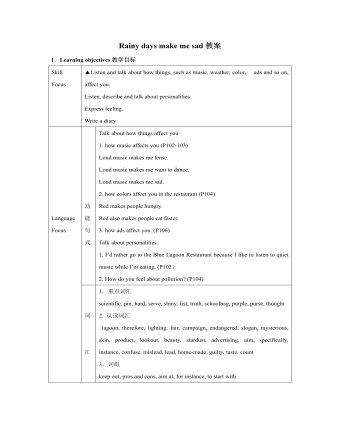
人教版新目标初中英语九年级下册Rainy days make me sad教案
1. 教材分析本单元以how do things affect you?为话题, 从颜色、天气、音乐、广告、产品等方面谈论了外界事物如何影响人的心情。要求学生掌握表达某物或某事给人带来的感觉、看法或影响等。共设计了四个部分的内容:Section A 该部分有4个模块:第一模块围绕Which restaurant would you like to go to?这一话题展开思维(1a)、听力(1b)、口语(1c)训练;第二模块围绕How does music affect you? 进行听力(2a-2b)、口语训练(2c);第三模块继续围绕how do colors in the restaurant affect you这一话题展开训练,训练形式为阅读和问题体验(3a)和小组活动(3b);第四模块仍就How do things affect you这一话题以调查的形式展开讨论。Section B该部分有4个模块:第一模块围绕产品广告对人们的影响这一话题以“配对”(1a)与“列举”(1b)两种形式展开训练;第二模块继续围绕How do things affect you? 进行听力(2a-2b)、口语对话训练(2c);第三模块围绕“Advertising”这一话题展开阅读(3a-3b)和写作(3c)训练;第四模块围绕How posters affect you这一话题以口语训练形式展开小组活动。
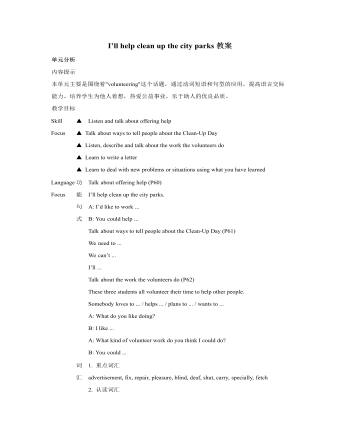
人教版新目标初中英语九年级下册I’ll help clean up the city parks教案
Talk about offering help (P60)I’ll help clean up the city parks.A: I’d like to work ...B: You could help ...Talk about ways to tell people about the Clean-Up Day (P61)We need to ...We can’t ...I’ll ...Talk about the work the volunteers do (P62)These three students all volunteer their time to help other people.Somebody loves to ... / helps ... / plans to ... / wants to ...A: What do you like doing?B: I like ... A: What kind of volunteer work do you think I could do?B: You could ...1. 重点词汇advertisement, fix, repair, pleasure, blind, deaf, shut, carry, specially, fetch2. 认读词汇hunger, homeless, cheer, clean-up, sign, establish, major, commitment, elementary, veterinarian, coach, similar, call-in, strategy, disabled, organization, unable, support, appreciate, donation, part of speech, pronoun, adverb, preposition, conjunction, donate, Jimmy, Sally3. 词组clean up, cheer up, give out, put off, set up, think up, take after, fix up, give away, put up, hand out, work out, at once
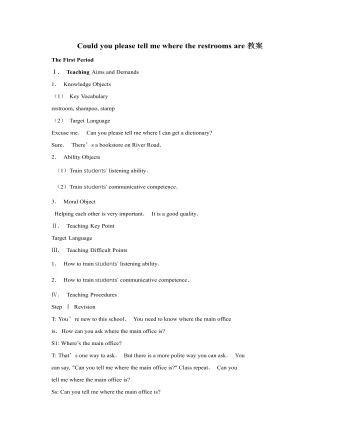
人教版新目标初中英语九年级下册Could you please tell me where the restrooms are教案
Step Ⅰ RevisionCheck homework. Ask a few students to read the article in 3a.Then ask a few students to read their guides.Step Ⅱ Part 1Look at the words in the box. Ask a student to read them. Make sure the students understand the meaning of the words. You are to fill in the blanks with the words. In some cases, students may need to use another form of the word, for example adjusting for tense or subject/ verb agreement.Ask students to fill in the blanks on their own.Check the answers. Step ⅢPart 2Go through the instructions with the class.Look at the example with the students.Ask students what the answer would be.Ask a student to read the question and answer it.Excuse me, could you tell me where the bank is, please?The bank is across the street from the shopping malt.Get students to complete the work in pairs.Check the answers. Ask a few students to read their questions.Step Ⅳ Just for Fun!Ask all the students to read the conversation. Ask: What is funny about this cartoon? Help students to explain. A Martian is a person from the planet Mars.There is no such thing as Martian food on Earth, and the clerk looks silly because he is trying to think of where there is a Martian restaurant.Invite some pairs of students to present this conversation to the rest of the class.Step Ⅴ Summary and HomeworkIn this class, we’ve done much writing practice using the key vocabulary words and the target language presented in this unit. After class, please finish the questions in 2 in your exercise books. Then finish the exercises on pages 47~48 of the workbook as well.The Seventh Period Ⅰ Teaching Aims and Demands1. Knowledge Objects(1) Key Vocabularyimage, adventure, jealousy, hero, crime, journey, brave, no longer, show interest in, take it easy, become interested in, plain looks(2)Text:Grown-ups like cartoons, too.2. Ability Objects(1) Fast-reading to get a general idea of the text.(2) Careful-reading to get the detailed information in the text.
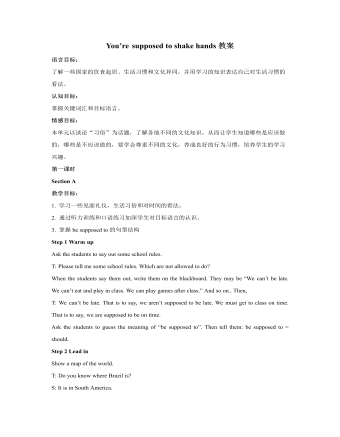
人教版新目标初中英语九年级下册You’re supposed to shake hands教案
教学目标:1. 掌握本单元一些重点词汇的写法和用法。2. 学会自如谈论餐桌礼仪。Step 1 RevisionAsk some students to retell the customs at the table in France in the passage in 3a.Step 2 Self checkPart 1. Fill in each bland with the correct word given. Students do the exercises by themselves at first. Then check the answers. Ask the students to comprehend the sentences and help them point out uses of some words, like “arrive (at / in) sw., spend time / money on sth , spend time / money (in) doing sth.”Part 2. Read about Fan Ling’s experience in a western restaurant. Understand the passage. Point out some key points in the passage.1. be / get used to doing sth. 习惯做某事2. begin with = start with 以….开头3. crowd v. 挤满,塞满 the crowd 人群 crowded adj. 拥挤的Then students discuss about how she would solve her problem. Ask some to share their stories with others.Part 3. Complete the crossword by looking at the sentences on the left. Then check the answers.
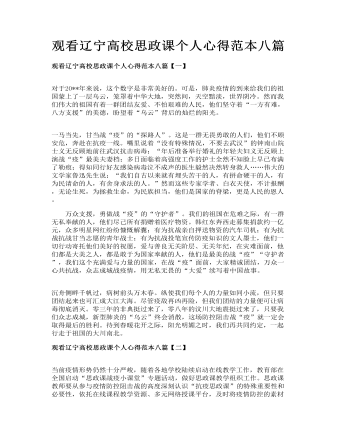
观看辽宁高校思政课个人心得范本八篇
万众支援,勇做战“疫”的“守护者”。我们的祖国在危难之际,有一群无私奉献的人,他们尽己所有捐赠着医疗物资。韩红东奔西走募集捐款约一亿元,众多明星网红纷纷慷慨解囊;有为抗战亲自押送物资的汽车司机;有为抗战抗战甘当志愿的青年战士;有为抗战投笔宣传防疫知识的文人墨士,他们一切行动寄托他们美好的祝愿,爱与善良无关阶层、无关年纪,在灾难面前,他们都是大美之人,都是敢于为国家奉献的人,他们是最美的战“疫”“守护者”,我们这个充满爱与力量的国家,在战“疫”面前,大家精诚团结,万众一心共抗战,众志成城战疫情,用无私无畏的“大爱”续写着中国故事。
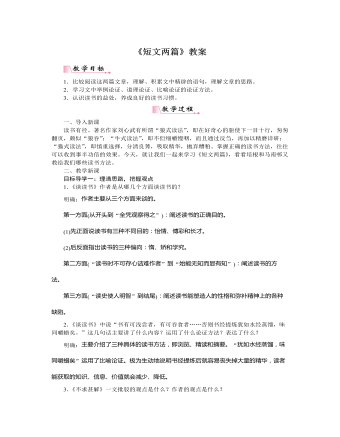
部编版语文九年级下册《短文两篇》教案
4.《不求甚解》一文分析了陶渊明怎样的读书态度,请指出“不求甚解”的两层含义。明确:态度:养成“好读书”的习惯;读书要诀在于“会意”。含义:第一,虚心,书不一定都能读懂;第二,读书方法:不固执一点,而要了解大意。5.《不求甚解》一文是驳论文还是立论文?又是如何驳或者立的?谈一谈你的理解。明确:驳论文。驳的是“论点”,先全面阐述“不求甚解”的含义,进而提倡虚心的“不求甚解”的读书态度,从而表明自己的观点;又从“会意”角度,列举古人读书的例子,并阐明自己的正确论点:读书在会意,不要死抠字眼,为一个局部而放弃整体;最后又强调了“书必须反复读”的主张。这样通过树立自己正确的观点从而驳倒敌论。
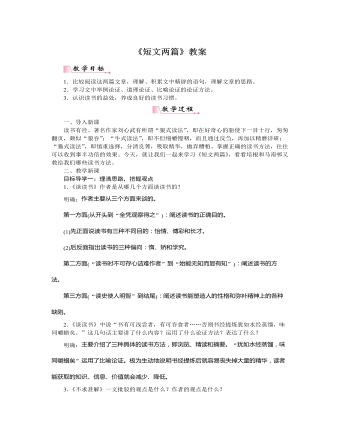
部编版语文九年级下册《短文两篇》教案
4.《不求甚解》一文分析了陶渊明怎样的读书态度,请指出“不求甚解”的两层含义。明确:态度:养成“好读书”的习惯;读书要诀在于“会意”。含义:第一,虚心,书不一定都能读懂;第二,读书方法:不固执一点,而要了解大意。5.《不求甚解》一文是驳论文还是立论文?又是如何驳或者立的?谈一谈你的理解。明确:驳论文。驳的是“论点”,先全面阐述“不求甚解”的含义,进而提倡虚心的“不求甚解”的读书态度,从而表明自己的观点;又从“会意”角度,列举古人读书的例子,并阐明自己的正确论点:读书在会意,不要死抠字眼,为一个局部而放弃整体;最后又强调了“书必须反复读”的主张。这样通过树立自己正确的观点从而驳倒敌论。

